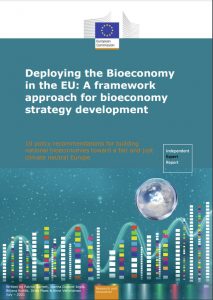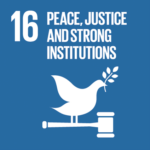10 policy recommendations for EU member states to build their national bioeconomy policies

Blog - Published 1.12.2021
Ten policy recommendations are used to incentivize EU member countries to build their national bioeconomy strategies and policies in ways that lead to a fair, just, low-carbon Europe.
The recommendations were drafted by a panel of experts selected by the EU Commission. The panel finalized their work in July and released the report: Deploying the bioeconomy in the EU – A framework approach for bioeconomy strategy development: 10 policy recommendations for building national bioeconomies toward a fair and just climate neutral Europe.
The report lists 10 recommendations for member countries that might prove useful when preparing bioeconomy strategies and for briefing bioeconomy politicians. The recommendations are applicable in the startup phase, as well as during network building and process management.
The need for national and regional bioeconomy strategies is emphasized in the EU Bioeconomy Strategy, updated in 2018, as well as in the conclusions drawn by the EU Commission during Finland’s EU Presidency in 2019.
The conclusions are, in part, based on a view embedded in the EU Bioeconomy Strategy that there is untapped bioeconomy, as well as added value growth potential in Central and Eastern Europe, in particular.
The opportunities include growth in the production of sustainable biomass, as well as improvement in rural development and the recyclability of biomass. The upgraded recommendations are designed to support the larger strategy.
The Recommendations are Based on Experiences Gathered from EU Member Countries
The EU Commission formed a panel consisting of bioeconomy experts in member countries. The work was supervised by four independent experts. I served as the chairman of the panel, and Sari Tasa of the Ministry of Economic Affairs and Employment of Finland represented Finland. The group worked virtually via the Internet. Visits to Poland, Latvia, Slovenia, and Bulgaria, were also carried out virtually.
During the virtual meetings representatives of member countries presented their experiences regarding what works best when preparing for and carrying out a specific bioeconomy strategy. The report contains such examples from Italy, France, the Czech Republic, Germany, Austria, Ireland, Hungary, Estonia, and Finland. The discussions resulted in 10 policy recommendations.
Finland’s bioeconomy strategy upgrade in light of the recommendations
Finland’s bioeconomy strategy upgrade is currently being implemented, providing us with an interesting opportunity to compare policy recommendations and the upgrade process.
Our first bioeconomy strategy was released in 2014, so the foundation for some of the recommendations in the report has been in existence for quite some time. Similarly, Finnish policy makers and stakeholders recognize the significance of having a bioeconomic policy. This is demonstrated by a policy as well as the resources for its upgrade being included in the implementation plan of the current Government Program.
The preparation committee of the bioeconomic strategy appointed by the Ministry of Economic Affairs and Employment of Finland found that the vision, definition, and goals of bioeconomy were in need of an update to reflect the current situation. Extensive background analyses – scenarios, swot-analyses, analyses of the current strategies, etc. – were commissioned to provide support for the upgrade. The preparation committee then selected increasing the added value of bioeconomy as the foundation for its strategy. One aspect leading to this decision was the effect of the reduction of the paper industry on the tree breeding value of the forest industry.
The policy recommendation of the EU panel is to create spaces and platforms that help spread awareness of bioeconomy and assist in building leadership for bioeconomic activities. A well-functioning, phenomenon-based cooperation and division of tasks among the ministries already exists in Finland. Stakeholders are included actively in the planning and implementation of bioeconomy. The National Bioeconomy Panel is considered the most significant tool for said cooperation. The Bioeconomy panel was hard at work during the entire upgrade process, making it obvious that Finland’s bioeconomy benefits from having a community committed to participating in a sophisticated bioeconomy discussion. Meaningful change is always dependent on an open exchange of ideas among the invested parties. The Bioeconomic panel also provided a platform for airing out dissenting views on how to achieve a thriving bioeconomy.
The fact that different geographical areas of Finland participated in the preparation work was also valuable. A total of 12 regional bioeconomic forums were held focusing on the strengths perceived by each region on which they wish to base their coherent and realistically attainable bioeconomy. One of the conclusions was that in order to fulfil and implement a bioeconomic strategy, it is important to form partnerships that lead to investments. Each region is encouraged to prepare a bioeconomic action plan for their locality. One challenge for the future worth mentioning is to achieve cooperation across county lines.
It is important to be able to monitor the effects of a bioeconomic strategy once it has been implemented. When compiling the first strategy we did not have access to comprehensive bioeconomy statistics in comparison to our gross domestic product. Having access to the Natural Resources Institute’s Finland’s Bioeconomy in Numbers statistics this time around made, say, studying the development of added value much more enjoyable.
At the core of updating the bioeconomic strategy is our support of pathways between bioeconomic policy, finance, national and EU-level research infrastructure, as well as between innovation and investment agendas both regionally and nationally. All in all, our upgrade meets the policy recommendations set by the EU panel of experts.
10 policy recommendations
For a more detailed description, please see Deploying the bioeconomy in the EU.
Getting Started
1. Ensuring that decisionmakers and stakeholders recognize the importance of bioeconomy
2. Transitioning from the concept of bioeconomy to developing a vision
3. Creating platforms for building collective concept and leadership
Building Transformative Coalitions
4. Supporting the various sectors across government involved in the planning and development of bioeconomy strategy
5. Identifying the existing bioeconomy initiatives aimed at creating a realistic and implementable action plan
6. Establishing bioeconomy partnerships for the purpose of co-investment
Steering the Process
7. Developing linkages and pathways between bioeconomy policy, funding and national and EU strategic research, infrastructure, innovation, and rural and regional investment agendas
8. Addressing the concerns and resistance of incumbent industries and patterns of behavior of citizens and consumers
9. Encouraging diffusion of bio-based knowledge, innovation and technological advances to support rural and regional development
10. Evaluating progress to help steer development towards sustainable, circular bioeconomies
Agenda2030
10 bioeconomy policy recommendations for good governance and sustainable development, 16:7 in particular: Ensuring a flexible, all inclusive, participatory, and representative decision making at all levels.


